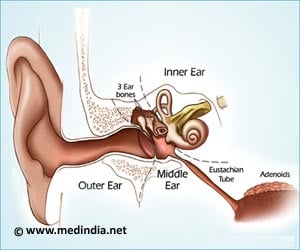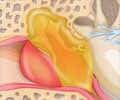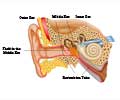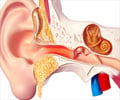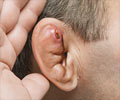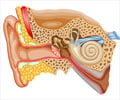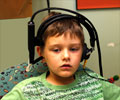- Current Medical Diagnosis and Treatment 2012
- Sander R. Otitis Externa: A Practical Guide to Treatment and Prevention. Am Fam Physician. 2001 Mar 1;63(5):927-937
About
Ear discharge is of different types depending on the underlying cause.

Ear infection is very common in babies and young children. The middle ear gets infected due to a direct connection with the upper respiratory system via the Eustachian tube. Middle ear infection is more common in children due to the shorter, narrower and more horizontal structure of the Eustachian tube. Nasal infection results in obstruction to the opening of the Eustachian tube. This is followed by accumulation of fluid in the middle ear, which later gets infected.
The middle ear is separated from the outer ear by a membrane called the eardrum or tympanic membrane. Thus, the infection of the middle ear does not cause ear discharge unless the eardrum ruptures. The outer ear canal usually secretes wax; ear discharge commonly consists of excessive wax. In some cases however, it may include blood, pus or fluid in addition to wax.
The type of ear discharge gives a clue of the underlying cause. For example:
- A scant white mucus discharge indicates acute external ear infection.
- A fungal infection of the external ear results in a fluffy white to off-white discharge. In some cases however, the discharge may be black, gray, bluish-green or yellow.
- A white to yellow mucus discharge with pus and deep pain indicates middle ear infection with perforated eardrum.
- A purulent mucus discharge without pain which is present sometimes and absent at other times may indicate chronic middle ear infection.
- Infection of the bone around the ear results in ear discharge with a bad odor.
- A clear, thin and watery discharge following head injury could indicate a fracture in the skull.
- Trauma to the ear may result in a bloody mucus discharge.
Causes
Middle ear infection is usually caused by bacteria, whereas external ear infection may be caused by bacteria or fungi.
Ear infection or ear discharge is diagnosed using an instrument called an otoscope. The otoscope enables direct visualization of the external canal and the eardrum. During the examination, a gentle puff of air is blown at the eardrum in order to determine if there is a fluid in the middle ear. Normally, the eardrum will move back and forth; but if there is excess of fluid, the eardrum will not move.
Infection of the middle ear is referred to as otitis media, whereas infection of the outer ear is called otitis externa. The infection may be acute or chronic.
Otitis media is caused by:
- Bacteria: Bacteria such as Streptococcus pneumoniae, Streptococcus pyogenes, Haemophilus influenzae and Moraxella catarrhalis account for nearly 85% of the cases.
The infection usually follows a common cold with viruses such as respiratory syncytial virus, rhinovirus and influenza virus. After a few days of stuffy nose, the patient suffers from severe ear pain due to accumulation of fluid and a buildup of pressure behind the eardrum. The pain usually settles in a day or two but can last over a week. The fluid accumulation is followed by secondary bacterial infection.
Children with middle ear infections often suffer from fever. A rupture of the eardrum results in relief of pain and drainage of pus into the ear canal. The drainage is usually milky white to yellow, sometimes with a foul odor. It is treated with antibiotics.
Otitis externa is caused by:
- Bacteria: Bacteria like Pseudomonas and Staphylococcus aureus cause otitis externa
- Fungi: The external ear canal is warm and dark, thereby providing an excellent environment for fungal growth. Fungi like Aspergillus fumigates, Aspergillus niger, Candida albicans and Candida tropicalis cause infection of the outer ear. Fungal infection is also common following prolonged treatment of bacterial infection with antibiotics.
Symptoms of otitis externa include itching, scaling with a red or moist ear canal and pain that increases with the movement of ear lobe, including chewing. This type of infection is common in swimmers and hence referred to as Swimmer’s ear. Inflammation and swelling of the skin of the ear may result in a feeling of fullness in the ear and loss of hearing. In some cases, a purulent discharge may be present. Bacterial infection can spread to the skull bone especially in patients with diabetes or reduced immunity resulting in a condition called malignant external otitis.
In case of fungal otitis externa, the patient may not suffer from any symptoms or may complain of discomfort with itching and a feeling of fullness in the ear. The ear canal should be cleaned thoroughly with 1% acetic acid in the alcohol. Clotrimazole is most effective in these cases. Antibiotic drops are used to treat bacterial infection.
Besides infection, other causes of ear discharge are:
- Excessive Earwax: Earwax draining from the ear is normal and does not require medical intervention, besides regular removal by a specialist. Sometimes, the wax may cause obstructive symptoms where the patient gets a feeling of fullness or pressure in the ear as well as slight hearing loss.
- Ruptured Eardrum: Middle ear infection can result in rupture of the eardrum. Other causes of rupture of eardrum include head injury, insertion of foreign objects like hairpins in the ear canal, exposure to very loud noises or sudden pressure changes (as in an air plane). Dry crusted material on a child’s pillow is a sign of ruptured eardrum. Drainage in case of ruptured eardrum is usually clear but slightly tinged with blood. It may be milky white to yellow in the presence of infection. A ruptured eardrum is diagnosed with an otoscope.
- Foreign Objects in the Ear: A foreign material that remains in the ear can get infected and cause ear discharge. This cause should be kept in mind especially while examining a child with ear discharge.
- Head Injury: Head injury is one of the most serious causes of ear drainage and requires immediate medical intervention. A clear and watery drainage following head injury maybe due to leakage of cerebrospinal fluid indicating a fracture of the skull.
- Eczema: Eczema and other skin conditions affecting the outer ear can also cause ear discharge.
FAQs
1. Which doctor should I visit in case I suffer from ear discharge?
You should visit an ENT (Ear-Nose-Throat) specialist in case you suffer from ear infection.
2. When does ear discharge indicate a serious problem?
A clear ear discharge following a head injury could be due to a fracture in the skull and should be attended to immediately. In addition, ear discharge due to infection should be treated at the earliest to avoid hearing loss.
3. What is the function of wax in the ear?
Wax is normally secreted by the glands lining the ear canal. It protects the ear by trapping dust and microorganisms. It also prevents irritation of the ear canal when it comes in contact with water.


